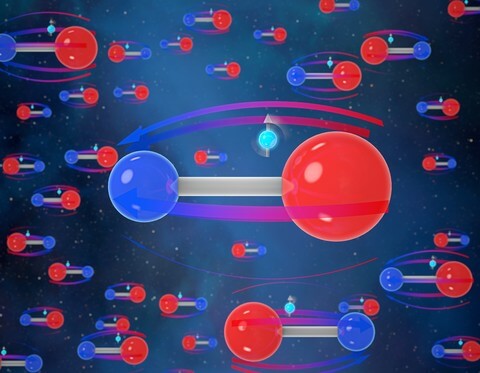In the first moments of our universe, countless numbers of protons, neutrons and electrons formed alongside their antimatter counterparts. As the universe expanded and cooled, almost all these matter and antimatter particles met and annihilated each other, leaving only photons, or flashes of light, in their wake.
And if the universe were perfectly symmetrical, with equal amounts of matter and antimatter, that would be the end of the story — and we would never have existed. But there must have been an imbalance — some leftover protons, neutrons and electrons — that formed atoms, molecules, stars, planets, galaxies and eventually, people.
“If the universe had been perfectly symmetrical, then there would be nothing left but light. This is a hugely important moment in history. Suddenly there is stuff in the universe, and the question is, why?” said NIST/JILA Fellow Eric Cornell. “Why do we have this asymmetry?”
The mathematical theories and equations that explain our universe call for symmetry. Particle theorists have refined these theories to tackle the presence of asymmetry. But without evidence, those theories are just math, Cornell explains, so experimental physicists including his group at JILA have been looking at fundamental particles such as electrons for signs of asymmetry.
Now, the JILA group has made a record-breaking measurement of electrons, narrowing down the search for where this asymmetry came from. Its findings have been published in Science.
JILA is jointly operated by the National Institute of Standards and Technology (NIST) and the University of Colorado Boulder.
“This is a hugely important moment in history. Suddenly there is stuff in the universe, and the question is, why?” —NIST/JILA Fellow Eric Cornell
One place to look for evidence of asymmetry is in the electron’s electric dipole moment (eEDM). Electrons are made up of negative electric charge, and the eEDM indicates how evenly that charge is spread between the electron’s north and south pole. Any measurement of eEDM above zero would confirm an asymmetry; the electron would be more egg-shaped than circular. But no one knows just how small that deviation may be.
“We need to fix our math to be closer to reality,” said Tanya Roussy, a graduate student in Cornell’s research group at JILA. “We’re looking for places where that asymmetry might be, so we can understand where it came from. Electrons are fundamental particles, and their symmetry tells us about the symmetry of the universe.”
Cornell, Roussy and their team at NIST and JILA recently set a record for precision measurement of eEDM, improving on previous measurements by a factor of 2.4.
How precise is that? If an electron were the size of the Earth, their study found that any asymmetry that exists would be smaller than the radius of an atom, Roussy explained.
Making a measurement that precise is incredibly difficult, she adds, so the group needed to be clever. The researchers looked at molecules of hafnium fluoride. If they applied a strong electric field to the molecules, non-round electrons would want to align with the field, shifting around inside the molecule. If they were round, then the electrons wouldn’t budge.
Using an ultraviolet laser, they stripped electrons off molecules, making a set of positively charged ions, and trapped them. Alternating the electromagnetic field around the trap, the molecules were forced to either align or not align with the field. Then the researchers used lasers to measure the energy levels of the two groups. If the levels were different between them, that would indicate that the electrons were asymmetrical.
Their experiment allowed them to have longer measurement times than past attempts, which gave them greater sensitivity. However, the group’s measurements showed that the electrons didn’t move energy levels, indicating that as best as we can presently measure, electrons are round.
There’s no guarantee that anyone will find a nonzero measurement of eEDM, Cornell points out, but this level of precision from a tabletop experiment is an achievement. It shows that expensive particle accelerators are not the only means of exploring these fundamental questions about the universe, and that there are a lot of avenues to try. And while the group didn’t find asymmetry, its result will help the field keep looking for answers to the asymmetry of the early universe.
“We found up to our measurement the electron is symmetric. If we would have found nonzero, it would be a big deal,” Roussy added. “The best bet is to have teams of scientists around the world looking at different options. As long as we all keep measuring the truth, eventually someone will find it.”
Paper: Tanya S. Roussy, Luke Caldwell, Trevor Wright, William B. Cairncross, Yuval Shagam, Kia Boon Ng, Noah Schlossberger, Sun Yool Park, Anzhou Wang, Jun Ye and Eric A. Cornell. A new bound on the electron’s electric dipole moment. Science. Published online July 6, 2023. DOI: 10.1126/science.adg4084


